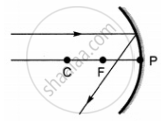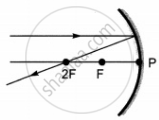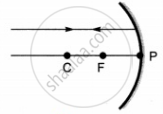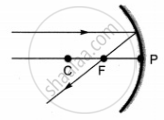Advertisements
Advertisements
Question
An object is placed at a large distance in front of a concave mirror of radius of curvature 40 cm. The image will be formed in front of the mirror at a distance:
(a) 20 cm
(b) 30 cm
(c) 40 cm
(d) 50 cm
Solution
20 cm
APPEARS IN
RELATED QUESTIONS
It is desired to obtain an erect image of an object, using concave mirror of focal length of 12 cm.
What should be the range of distance of an object placed in front of the mirror?
It is desired to obtain an erect image of an object, using concave mirror of focal length of 12 cm.
Will the image be smaller or larger than the object? Draw ray diagram to show the formation of image in this case.
A student wants to project the image of a candle flame on a screen 48 cm in front of a mirror by keeping the flame at a distance of 12 cm from its pole.
(a) Suggest the type of mirror he should use.
(b) Find the linear magnification of the image produced.
(c) How far is the image from its object?
(d) Draw ray diagram to show the image formation in this case.
Fill in the following blank with suitable word:
The focal length of a concave mirror is the distance from the ......... to the mirror.
The real image formed by a concave mirror is smaller than the object if the object is:
(a) between centre of curvature and focus
(b) at a distance greater than radius of curvature
(c) at a distance equal to radius of curvature
(d) at a distance equal to focal length
The focal length of a small concave mirror is 2.5 cm. In order to use this concave mirror as a dentist's mirror, the distance of tooth from the mirror should be:
(a) 2.5 cm
(b) 1.5 cm
(c) 4.5 cm
(d) 3.5 cm
Why does a beam of light when it enters glass at an angle? Why does it not bend if it inters the glass at right angles?
Radius of curvature of a spherical mirror is ............. its focal length.
Name the mirror(s) that can give (i) an erect and enlarged image, (ii) same sized, inverted image
Which of the following ray diagrams is correct for the ray of light incident on a concave mirror as shown in figure?

 |
 |
 |
 |
| A | B | C | D |
